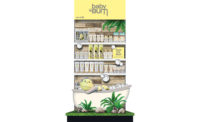Spotlight Feature, part 1 of 2
Re-Commerce: Online Retail Moves to Brick and Mortar
Second-hand online retail shops are lending a hand to struggling stores in order to grab the attention of younger generations.

The global e-commerce packaging marketing is projected to see a compound annual growth rate of 11.3% through 2023, cites The Freedonia Group. Apparel and accessories alone took 18% of the market in 2018. Key trends in e-commerce include growth in products needing high-value packaging, expansion of online order fulfillment infrastructure in less developed geographic markets; and right-sizing of boxes that reduce protective packaging needs.
Westrock’s BoxSizer, for example, is an automated packaging machine that works well for online retailer packaging. The automated machine is the only one on the market that can right-size multiple preloaded box footprints arriving at random to the infeed, reducing costs around labor, void fill and shipping — without the need for changeover.
But, it isn’t only in e-commerce where online retailers may prevail. Apparel retailers traditionally known for their brick-and-mortar stores, with many departments, makeup and cologne counters as well as jewelry, are now facing a tough fact: They are not getting the younger generations in-store. As millennials and those younger, in the Generation Z demographic, prefer second-hand shopping for apparel and accessories, some retail chains decided that they were going to do something about the missed generations.
Re-commerce is the practice of selling second-hand or excess inventory of clothing, shoes, accessories, home décor and jewelry in-store instead of (or in addition to) an e-commerce platform.
Both millennial and Generation Z consumers are embracing the concept of purchasing secondhand goods. They are also more than two times likely to engage with re-commerce than older consumers, according to GlobalData in its “2019 Annual Resale Report” for thredUP.

Yet now consumers can find repurposed clothing and more at brick-and-mortar retail stores including JCPenney, Macy’s, Bealls and others. thredUP, the world’s largest online consignment store, has pop-up stores in JCPenney, Bealls, Stage, Goody’s, Palais Royal, Peebles and Macy’s. It isn’t only out-of-date clothing and goods; many of the items are on-trend and from overstock. The pilot programs are in 100 stores, with plans for more in the future.
JCPenney Company Inc. just announced that 30 of its stores will offer a selection of secondhand women’s clothing and handbags from thredUP, featuring like-new styles from leading designers and brands. As part of a company effort to launch new customer offerings, each pop-up shop at stores will be refreshed weekly to offer continued newness and excitement for shoppers, as well as compelling price points.
By shopping thredUP in a brick-and-mortar environment, consumers have the opportunity to see, feel and try on the item at JCPenney, as well as use existing promotional offers to maximize their savings.
“With the rise of online resale markets, there’s no doubt that demand for great value on quality brands is at an all-time high. There’s an emotional thrill that comes with finding one-of-a-kind secondhand product for much less,” said Michelle Wlazlo, executive vice president and chief merchant for JCPenney. “While there are more secondhand shoppers than ever before, we’ll continue to test and evaluate how this resonates with customers. We’re excited about the prospect of creating a new in-store experience that makes high-end brands attainable, as well as catering to eco-minded consumers who want more sustainable options in their wardrobe.”
Macy’s will be trialing resale services in 40 of its outlets across the U.S. through its alliance with thredUP, which it hopes will reach millennials and Gen Z shoppers who have undying passion for fashion sustainability and shopping resale.
“The partnership with thredUP gives us the opportunity to reach new customers and keep them coming back to shop ever-changing selection of styles and brands that we don’t typically carry,” said Jeff Gennette, chief executive officer, Macy’s.
thredUP also offers a “Clean Out Kit” program — donation bags that consumers can use to get rid of unwanted clothing or accessories. The online retailer offers them at all of their pop-up locations.
This could be a great opportunity to get consumers who may not usually shop at JCPenney or Macy’s into their doors. However, sources say that the pilot programs may not help these stores, which usually see an older clientele. Both stores are seeing slumps, according to Business Insider.
Repurpose for the Environment
The equivalent of one garbage truck of textiles is sent to a landfill or incinerated every second, according to The Ellen MacArthur Foundation. Consumers, especially the younger generations, want the brands they buy to be conscious of the environmental impact of their practices. thredUP, for example, estimates that it has upcycled 65 million articles in the past five years — 21 million in 2018 alone — saving these items from landfills.
Many brands still destroy “deadstock” by burning the items. Partnerships with re-commerce merchants allow brands to showcase their concern about the environment and increase customer loyalty.
A Need for Luxury Packaging Design
For e-commerce specifically, 21.7% of the world’s population – 2.14 billion people – are expected to buy online by 2021, says Robert Lockyer, CEO of Delta Global, which designs and implements sustainable packaging solutions for designers such as Tom Ford, Coach and Fortnum & Mason.

Online and in-store packaging that takes equal consideration is something that often divides a room but Lockyer believes brands should be creating the same attention to detail with their online packaging as they would with their in-store offering.
“In-store experiences provide that all-important human-to-human interaction which goes towards maintaining customer loyalty, and that’s unfortunately something that online can’t match,” Lockyer says. “Some brands though, are using that as a reason to neglect their online packaging, opting instead for a cheaper, less thought-out solution.
“This ‘what we can’t see won’t hurt us’ approach is in actual fact damaging these brands’ chances of maintaining brand loyalty, because the importance of ‘consumer experience’ online is becoming imperative now more than ever.”
Consumers treat their own ‘customer experience’ as a top priority when deciding with whom to shop. A recent study revealed that 72% of American consumers say that packaging alone influences their purchasing decisions.
“Every consumer should be made to feel like they are the most important person to a retailer and be given a service that makes them want to come back,” Lockyer explains.
The proper packaging can open up a brand to a massive audience — from the delivery driver who carries it to the door, to colleagues in the office when it lands on your desk, plus the word of mouth that follows tcohat.
So, Lockyer says, when someone is shopping with that same brand online, the same level of care and attention-to-detail must be paid.
Brands seem to forget that, though it may cost a little more initially, getting packaging right and providing a ‘theatre’ behind the unwrapping process will actually increase their profitability long term through customer loyalty.
A large part of Delta Global’s work is helping its clients introduce e-commerce packaging designs that are built in-line with its other branding collateral.
Visit deltaglobal.co to learn more.
Looking for a reprint of this article?
From high-res PDFs to custom plaques, order your copy today!







